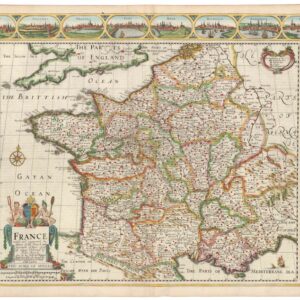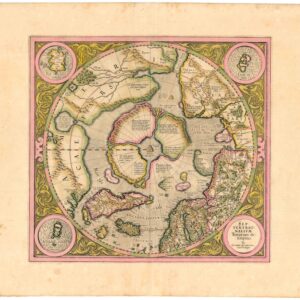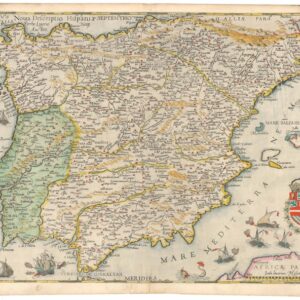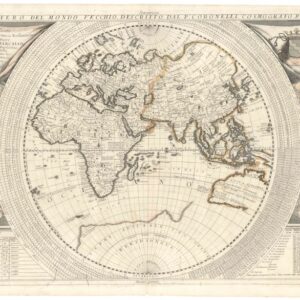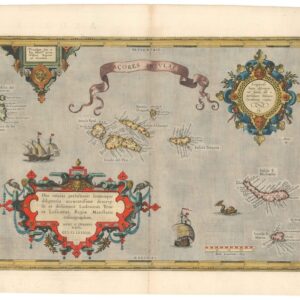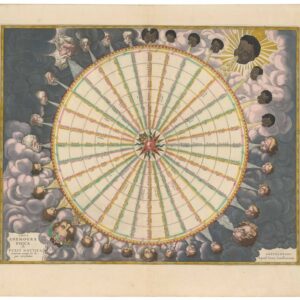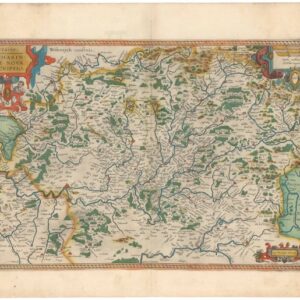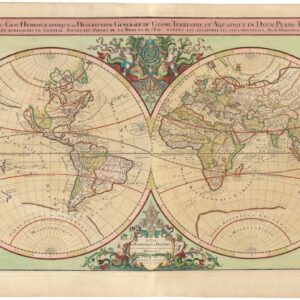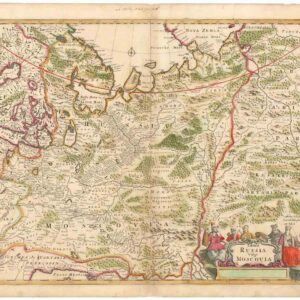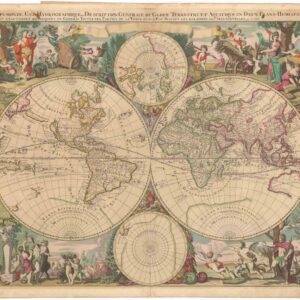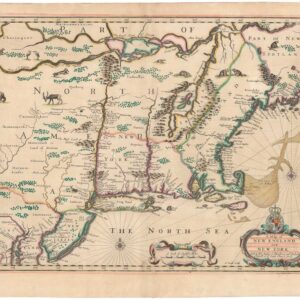Background: How to understand color on antique maps
The terms ‘Original’ or ‘Contemporary’ or ‘Old’ color are used for the most part interchangeably in the antiquarian map world to refer to color that was applied to a map immediately after or close to the time of its printing as part of the publication and selling process. Until the development of color printing (halftone, chromolithography, etc.), maps were colored by hand: sometimes by the publisher or people hired by the publisher, sometimes by independent colorists working for the map’s owner.
‘Modern color’ is used to describe color that was added long after initial production, even if the color is centuries old. Both in cases where original coloring faded or burned, and when maps were issued without color, it is not unusual to find 17th century maps colored (or re-colored) in the 18th and 19th centuries. This color is grouped with the work of present-day colorists under the term ‘modern,’ and when skillfully applied both can be quite visually pleasing.
Historical background
For most of the history of mapmaking, color was uncommon but not unknown.The oldest known maps were incised into clay tablets in ancient Babylon and could obviously not be colored. But as the medium evolved, we see that for some of the earliest preserved maps, coloring played an important role in encoding or embedding concepts in schematic visual renditions of the world. Impressive charts like the Tabula Peutingeriana, early Arab or Ptolemaic maps, the 6th century mosaic map in Madaba, Jordan, and Medieval portolan charts all used color to distinguish individual features and enhance the visual impact.
From the late 15th to the late 16th century, a period that saw the invention of the printed map and the rise of map publishing as a business, color remained uncommon. Maps would often figure within the context of geographic books or itineraries and would rarely be subjected to coloring. However, some map publishers did begin to color maps in order to make them more sellable by enhancing appearance and readability, as well as to highlight specific features conveyed in the map’s composition.
Coloring would be applied to maps for decorative purposes, and the more competitive the map business became, the greater the need to enhance them visually. During the 17th century and the Dutch Golden Age of cartography, the hand coloring of maps grew increasingly common and popular, and many mapmakers started issuing formal polychrome sheets to meet the growing demand. A pioneer in this regard – in part due to his technical skill and strong sense of aesthetic – was Willem Janszoon Blaeu, who began issuing magnificent tomes of hand-colored maps.
The depth and splendor of early coloring was in part due to the way pigments were prepared and used. Some of the pigment initially used in the hand-coloring of maps became unavailable during the 18th century, making the original techniques a lost art. Coloring was used in different ways and for different purposes. Four main colors were usually used to highlight political subdivisions: green, pink, orange, and yellow. A stylized cathedral colored in bright red or gold often marked larger urban centers, whereas blue was commonly reserved for denoting bodies of water. Black was the color most used for toponyms.
Discerning old color
If skillfully applied with historical correctness, modern coloring can sometimes be very difficult to distinguish from contemporary or original color. Discerning between the two takes experience.
When evaluating maps for original color, there are a number of features that one might look for in order to confirm that the coloring is indeed original. The most common and simple technique is to examine the verso of the map, as old greens and browns in particular often show through the paper as a result of oxidation.
Another common, albeit more difficult, way of discerning original color from later coloring is holding it up to historical and stylistic scrutiny. Often, the original coloring of landmasses constituted a reflection of political subdivisions at the time of publication. Such realities would sometimes either be forgotten or disregarded when maps were subjected to later coloring. The reason for discrepancies of this sort was usually the changing nature of political realities. The later coloring of maps with different political subdivisions could thus be construed as an error in historicity, but is much more likely because the desire for original states is a modern collectors phenomenon. In the 18th and early 19th century, far more importance was lent to maps be usable, and thus the need for updated political divisions was considered paramount.
-
- Add to cart
- France & Switzerland
France revised and augmented the attires of the French and Situations of their Cheifest cityes observed.
- $2,200
- Speed’s stunning map of France, produced at the height of religious war in Europe.
-
- Add to cart
- Polar - Arctic
Septentrionalium Terrarum descriptio.
- $4,800
- A superb original color example of Mercator's famed map of the North Pole.
-
- Add to cart
- Europe, Spain & Portugal
Nova Descriptio Hispaniae.
- $3,800
- One of the finest maps of the Iberian Peninsula ever produced, in excellent original color.
-
- Add to cart
- World
Planisfero Del Mondo Vecchio, Descritto Dal P. Coronelli, Cosmographo Publico.
- $2,800
- Coronelli’s masterful planisphere of the Old World with touches of original color.
-
- Add to cart
- Spain & Portugal
Acores Insulae.
- $950
- Discover the strategic and navigational significance of the 16th-century Azores with Ortelius' beautiful 1584 map from the famous Theatrum Orbis Terrarum.
-
- Add to cart
- Rare Maps of Curiosities - Miscellanea
Tabula Anemographica seu Pyxis Nautica.
- $2,850
- The first plate from the world's first sea atlas.
-
- Add to cart
- France & Switzerland
Lorraine. Lotharingiae Nova Descriptio.
- $350
- Old color Ortelius map of the Franco-German border region Lorraine.
-
- Add to cart
- Bird's-eye-views, Italy
Venetia.
- $2,700
- Gorgeous 1577 Braun & Hogenberg bird's-eye-view of Venice.
-
- Add to cart
- World
Mappe-Monde Geo-Hydrographique, ou Description Generale du Globe Terrestre et Aquatique en Deux Plans-Hemispheres ou Sont Exactement Remarquees en General Toutes Les Parties De La Terre et de L’Eau, Suivant les Relations Les Plus Nouvelles.
- $5,000
- Jaillot’s famous double-hemisphere in original color and with gold highlights.
-
- Add to cart
- Russia & Eastern Europe
Tabula Russia Vulgo Moscovia.
- $425
- A grand depiction of the Russian Empire by one of the best representatives of the Golden Age of Dutch cartography.
-
- Add to cart
- World
Mappe-monde géo-hydrographique, ou description générale du globe terrestre et aquatique en deux plans hémisphères.
- $3,500
- Gerald Valck’s world map in splendid original color.
-
- Add to cart
- United States, Eastern United States
A Map of New England and New York.
- $14,500
- A superlative copy of the finest 17th-century English map of New England, with fantastic old color and red-ruling denoting a noble English provenance.
